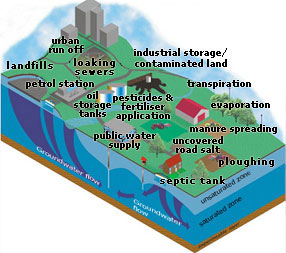Groundwater Issues
Summary of groundwater aspects of the Water Framework Directive
Introduction
The EU Water Framework Directive came into force on 22 December 2000. It was introduced in response to a consensus across Europe that water policy was fragmented. This single piece of framework legislation expands the scope of water protection to all bodies of water, surface water and groundwater, with the aim of achieving ‘good status’ by 2015.
Assessment and management of water bodies has been carried out on a River Basin District basis. Water bodies include lakes, reaches of rivers and groundwater bodies. Groundwater bodies are defined as distinct volumes of groundwater within an aquifer or aquifers. The definition of aquifer used in the Directive means that most of the rocks in the UK that were previously classified as non-aquifer material are now considered to be aquifers. Little of the UK is not underlain by a groundwater body.
Environmental objectives for groundwater
The Directive sets out a series of environmental objectives to be met. Those specifically for groundwater are:

Sources of groundwater pollution © NERC 1998
- to implement measures to prevent or limit the input of pollutants into groundwater and to prevent deterioration of groundwater;
-
to protect, enhance and restore all bodies of groundwater, ensure a balance between abstraction and recharge of groundwater, with the aim of achieving ‘good groundwater status’ within 15 years of the Directive coming into force, except under certain special circumstances;
-
to implement measures to reverse any significant and sustained upward trend in the concentration of any pollutant resulting from the impact of human activity in order to progressively reduce the pollution of groundwater; and
-
to ensure compliance with the relevant standards and objectives for ‘Protected Areas’ within 15 years of Directive implementation (includes groundwater bodies from which abstraction for human consumption exceeds 10 m3/d or serves greater than 50 persons).
Less stringent objectives for specific bodies of water may be set where these are so affected by human activity or their natural condition is such that it would be unfeasible or disproportionately expensive to reach good status. The 15-year target date can be extended where there are reasonable grounds.
Groundwater Status
Groundwater status consists of both quantitative (the amount of groundwater) and chemical (the quality of groundwater) components. Groundwater levels have been used as one of the measures of quantitative status, using a weight of evidence approach. To achieve good groundwater quantitative status, the available groundwater resource (i.e. the long-term average rate of overall groundwater recharge to the body less the long term annual rate of flow required to achieve the ecological quality objectives for associated surface waters) is not exceeded by the long-term annual average rate of abstraction. Groundwater abstraction must not also cause failure of good ecological status in dependent surface water bodies, significant damage of dependent wetlands (groundwater dependent terrestrial ecosystems) or saline or other intrusions.
Groundwater chemical status is measured by concentrations of pollutants and changes in electrical conductivity in the groundwater body such that it:
- does not exhibit effects of saline or other intrusions;
-
does not exceed the Community quality standards;
-
would not result in failure to achieve the environmental objectives in associated surface waters or terrestrial ecosystems.
Process and timetable
The process and timetable for Member States to achieve the environmental objectives, and significant deadlines for the Community to undertake actions within the Directive, are as follows (timings are relative to the date when the Directive came into force – 22 December 2000):
Within 2 years
- Commission to propose specific measures to establish criteria for assessing good groundwater chemical status and identifying trends in pollutants
Within 4 years
- identification of River Basin Districts and assignment of groundwater bodies to these Districts;
-
characterisation of the Districts;
-
identification and listing of protected areas;
-
review of the impact of human activity on the status of surface water and groundwater;
-
classification of water bodies, including those that are at risk of failing to meet environmental objectives. The latter must generally be characterised in more detail;
-
economic analysis of water use.
Within 5 years
- if not already set by Commission, Member States to establish criteria for assessing good groundwater chemical status and identifying trends in pollutants.
Within 6 years
- groundwater monitoring programme established;
-
Commission to put in place emission controls for point sources and environmental quality standards for substances on first list of priority substances.
Within 9 years
Within 10 years
- appropriate water pricing policies put in place.
Within 15 years
- Achievement of ‘good status’ in all water bodies except for those cases where extended deadlines or other objectives have been set in order to ensure measures are technically feasible and no disproportionately costly.
Explanation of aspects of the process
The Directive also addresses the requirement for:
- an economic analysis of water use;
-
recovery of costs for water services;
-
provision of public information and consultation.
Explanations of these aspects can be found at sites listed on the links page.
Repeal of existing legislation
Certain existing legislation will be repealed in due course as a result of the Water Framework Directive. The Groundwater Directive (80/68/EEC), protecting groundwater from pollution by certain dangerous substances, will be repealed in 2013. The Nitrates Directive (91/676/EEC) will remain in force.
Definitions of relevant terms used in the Directive
Groundwater - all water which is below the surface of the ground in the saturated zone and in direct contact with the ground or subsoil.
Aquifer - a subsurface layer or layers of rock or other geological strata of sufficient porosity and permeability to allow either a significant flow of groundwater or the abstraction of significant quantities of groundwater.
Body of groundwater - a distinct volume of groundwater within an aquifer or aquifers.
Back to the Water Framework Directive Main Page

Print this Page